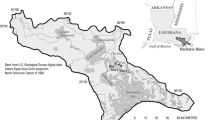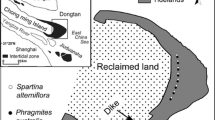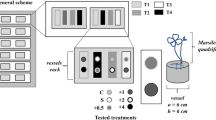Abstract
In tidal freshwater marshes of the Hudson River, coverage byPhragmites australis andLythrum salicaria has increased greatly over the past twenty years, althoughTypha angustifolia is still the predominant vegetation. Prior to any attempts at marsh restoration via removal of exotic/invasive plant species, we wanted to describe the current relationship between these plants and sediment nutrient pools. Extant stands (n=3 of each) ofT. angustifolia, L. salicaria, andP. australis were sampled with porewater equilibrators in the spring and summer of 1995 and summer 1996 to measure porewater ammonium, nitrate, and phosphate. Porewater pools of phosphate were significantly lower (p<0.05) in stands ofL. salicaria in summer, with concentrations only half those measured in stands ofP. australis andT. angustifolia. Porewater ammonium did not differ among plant communities, and nitrate was undetectable in sediments associated with all three communities. Sequestration of nutrients in above-ground biomass differed significantly among plant species, indicating differential demand on sediment nutrient pools. There were significant decreases in porewater ammonium from spring to summer. Growing season estimates of nitrogen incorporation into above-ground plant tissue are more than adequate to explain the removal of ammonium from porewater for all plant communities. Similarly, plant uptake of porewater phosphate was several times greater than springtime standing stocks of dissolved inorganic P. Concentrations of porewater phosphate remained high in the summer, indicating rapid replenishment from other sediment phosphorus pools. Depletion of porewater ammonium in the summer and low N:P in plant tissues suggest N limitation of these marsh plants. Our data suggest that marsh management practices intended to shift the relative vegetation coverage towards native and non-invasive species should consider the subtle but ecologically significant effects on nutrient cycling.
Similar content being viewed by others
Literature Cited
Armstrong, W. 1971. Radial oxygen losses from intact rice roots as affected by distance from the apex, respiration and waterlogging. Physiologia Planatarum 25:192–7.
Barko, J.W., D. Gunnison, and S.R. Carpenter. 1991. Sediment interactions with submersed macrophyte growth and community dynamics. Aquatic Botany 41:41–65.
Blossey, B., D. Schroder, S.D. Hight, and R.A. Malecki, 1994. Host specificity and environmental impact of the weevilHylobius transversovittatus, a biological control agent of purple loosestrife (Lythrum salicaria). Weed Science Society of America 42:128–133.
Bottomley, E.Z. and I.L. Bayley. 1984. A sediment porewater sampler used in root zone studies of the submerged macrophyte,Myriophyllum spicatum. Limnology and Oceanography 29:671–673.
Bowden, W.B. 1986. Nitrification, nitrate reduction and nitrogen immobilization in a tidal freshwater marsh sediment. Ecology 67: 88–99.
Chambers, R. M. and J.W. Fourqurean. 1991. Alternative criteria for assessing nutrient limitation of a wetland macrophyte (Peltrandra virginica (L.) Kunth). Aquatic Botany 40:305–320.
Correll, D.L., T.E. Jordan, and D.E. Weller. 1992. Nutrient fluxing landscape: effects of coastal land-use and terrestrial community mosaic on nutrient transport to coastal water. Estuaries 15:431–442.
Correll, D.S. and H.B. Correll. 1975. Aquatic and Wetland Plants of the Southwestern United States. Stanford University Press, Stanford, CA.
Drew, M.C., P.H. Saglio, and A. Pradet. 1985. Larger adenylate energy charge and ATP/ADP ratios in aerenchymatous roots ofZea mays in anaerobic media as a consequence of improved internal oxygen transport. Planta 175:51–8.
Ehrenfeld, J.G. 1995. Microsite differences in surface substrate characteristics inChamaecyparis swamps of the New Jersey pinelands. Wetlands 15:183–189.
Emery, S.L. and J.A. Perry. 1995. Aboveground biomass and phosphorus concentrations ofLythrum salicaria (Purple Loosestrife) andTypha spp. (Cattail) in 12 Minnesota Wetlands. American Midland Naturalist 134:394–399.
Findlay, S., K. Howe, and H.K. Austin. 1990. Comparison of detritus dynamics in two tidal freshwater wetlands. Ecology 71:288–295.
Grace, J.B. and R. Wetzel. 1981. Habitat partitioning and competitive displacement of cattail (Typha): experimental field studies. American Naturalist 118:463–474.
Hara, T., J. van der Toorn, and J.H. Mook. 1993. Growth dynamics and size structure of shoots ofPhragmites australis, a clonal plant. Journal of Ecology 81:47–60.
Harvey, J.W., R.M. Chambers, and J.R. Hoelscher. 1995. Preferential flow and segregation of porewater solutes in wetland sediment. Estuaries 18:568–578.
Hesslein, R.H. 1976. Anin situ sampler for close interval porewater studies. Limnology and Oceanography 21:912–914.
Howes, B.L., J.W.H. Dacey, and D.D. Goehringer. 1986. Factors controlling the growth form ofSpartina alterniflora: feedbacks between above-ground production, sediment oxidation, nitrogen and salinity. Journal of Ecology 74:881–898.
Howes, B.L., R.W. Howarth, I. Valiela, and J.M. Teal. 1981. Oxidation-reduction potentials in a salt marsh. Spatial patterns and interactions with primary production. Limnology and Oceanography 26:350–360.
Iversen, J.S. 1949. Determinations of the specific gravity of the roots of swamp, meadow and dry-soil plants. Oikos 1:1–5.
Jaynes, M.L. and S.R. Carpenter. 1986. Effects of vascular and nonvascular macrophytes on sediment redox and solute dynamics. Journal of Ecology 67:875–882.
Johnston, C.A., N.E. Detenbeck, and G.J. Niemi. 1990. The cumulative effect of wetlands on stream water quality and quantity: A landscape approach. Biogeochemistry 10:105–142.
Malecki, R.A., B. Blossey, S.D. Hight, D. Schroeder, L.T. Kok, and J.R. Coulson. 1993. Biological control of purple loosestrife. Bioscience 43:680–686.
Marks, M., B. Lapin, and J. Randall, 1994.Phragmites australis (P. communis): Threats, management and monitoring. Natural Areas Journal 14:285–294.
Mooney, H.A. and J.A. Drake (eds.), 1986. Ecology of Biological Invasions of North America and Hawaii. Springer Verlag, New York, NY, USA.
Orson, R.A., R.S. Warren, and W.A. Niering. 1987. Development of a tidal marsh in a New England River Valley. Estuaries 10:20–27.
Sifton, H.B. 1945. Air-space tissue in plants. Botanical Review 11: 108–43.
Stuckey, R.L. 1980. Distributional History ofLythrum salicaria (purple loosestrife) in North America. Bartonia 47:3–20.
Vitousek, P.M., C.M. D’Antonio, L.L. Loope, and R. Westbrooks. 1996. Biological invasions as global environmental change. American Scientist 84:468–478.
Walker, D. 1970. Direction and rate in some British post-glacial hydroseres. p. 117–139.In D. Walker and R.G. West (eds.) Studies in the Vegetational History of the British Isles. Cambridge University Press, Cambridge, England.
Wigand, C., J.C. Stevenson, and J.C. Cornwell. 1997. Effects of different submersed macrophytes on sediment biogeochemistry. Aquatic Botany 56:233–244.
Author information
Authors and Affiliations
Rights and permissions
About this article
Cite this article
Templer, P., Findlay, S. & Wigand, C. Sediment chemistry associated with native and non-native emergent macrophytes of a Hudson River marsh ecosystem. Wetlands 18, 70–78 (1998). https://doi.org/10.1007/BF03161444
Received:
Revised:
Accepted:
Issue Date:
DOI: https://doi.org/10.1007/BF03161444




